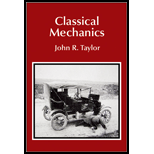
Concept explainers
(a)
The speed of either
(a)
Answer to Problem 15.74P
The speed of the newly formed particles in the rest frame of particle
Explanation of Solution
Write the expression for the relativistic momentum of particle
Here,
Write the expression for
Here,
Consider a particle
Write the expression for the conservation of momentum for the reaction in equation (III).
Here,
Use equation (I) and (II) to solve for the relativistic momentum of particle
Substitute
Substitute
The total energy of the particle
Write the expression for the conservation of energy.
Here,
Write the expression for the relativistic kinetic energy.
Use equation (VII) in (VI) to solve for the conservation of energy.
Substitute
Write the expression for the kinetic energy of first
Write the expression for the kinetic energy of second
Substitute
Use equation (V) in (XII) and squaring on both side to solve for
Squaring the equation (XIII) on both sides to solve for
Use the general solution of quadratic equation in (XIV) to solve for
Write the expression for the relativistic momentum of the second newly formed particle.
Substitute
Substitute
Substitute
Write the expression for the relativistic momentum of the first newly formed particle.
Substitute
Substitute
Substitute
Conclusion:
Therefore, the speed of the newly formed particles in the rest frame of particle
(b)
The velocities of the two
(b)
Answer to Problem 15.74P
The velocities of the newly formed particles in the frame of reference
Explanation of Solution
The relative velocity of the newly formed particles with respect to the frame of reference
Write the expression for the velocity of the newly formed particle in the
Here,
Substitute
Here,
Substitute
Here,
Substitute
Substitute
Conclusion:
Therefore, the velocities of the newly formed particles in the frame of reference
Want to see more full solutions like this?
Chapter 15 Solutions
Classical Mechanics
 College PhysicsPhysicsISBN:9781305952300Author:Raymond A. Serway, Chris VuillePublisher:Cengage Learning
College PhysicsPhysicsISBN:9781305952300Author:Raymond A. Serway, Chris VuillePublisher:Cengage Learning University Physics (14th Edition)PhysicsISBN:9780133969290Author:Hugh D. Young, Roger A. FreedmanPublisher:PEARSON
University Physics (14th Edition)PhysicsISBN:9780133969290Author:Hugh D. Young, Roger A. FreedmanPublisher:PEARSON Introduction To Quantum MechanicsPhysicsISBN:9781107189638Author:Griffiths, David J., Schroeter, Darrell F.Publisher:Cambridge University Press
Introduction To Quantum MechanicsPhysicsISBN:9781107189638Author:Griffiths, David J., Schroeter, Darrell F.Publisher:Cambridge University Press Physics for Scientists and EngineersPhysicsISBN:9781337553278Author:Raymond A. Serway, John W. JewettPublisher:Cengage Learning
Physics for Scientists and EngineersPhysicsISBN:9781337553278Author:Raymond A. Serway, John W. JewettPublisher:Cengage Learning Lecture- Tutorials for Introductory AstronomyPhysicsISBN:9780321820464Author:Edward E. Prather, Tim P. Slater, Jeff P. Adams, Gina BrissendenPublisher:Addison-Wesley
Lecture- Tutorials for Introductory AstronomyPhysicsISBN:9780321820464Author:Edward E. Prather, Tim P. Slater, Jeff P. Adams, Gina BrissendenPublisher:Addison-Wesley College Physics: A Strategic Approach (4th Editio...PhysicsISBN:9780134609034Author:Randall D. Knight (Professor Emeritus), Brian Jones, Stuart FieldPublisher:PEARSON
College Physics: A Strategic Approach (4th Editio...PhysicsISBN:9780134609034Author:Randall D. Knight (Professor Emeritus), Brian Jones, Stuart FieldPublisher:PEARSON





